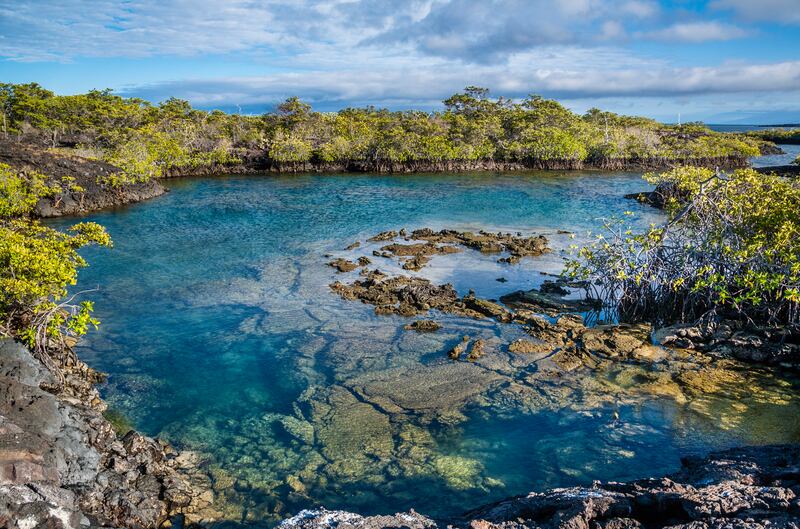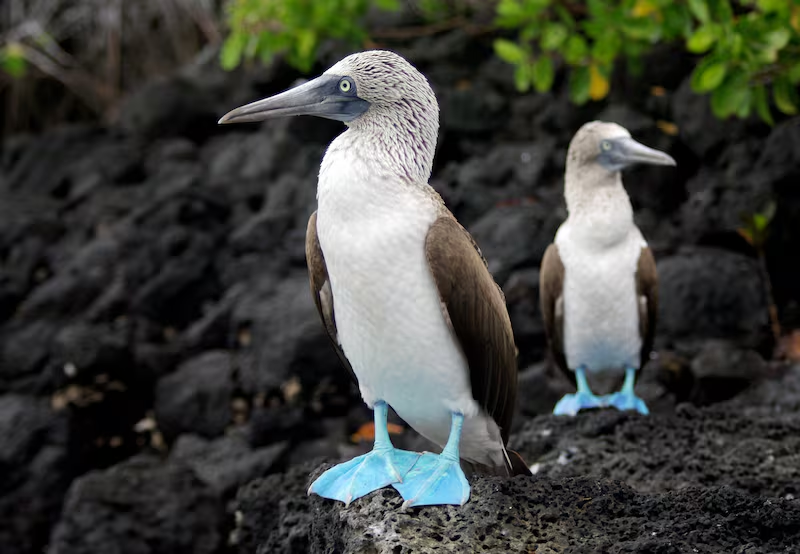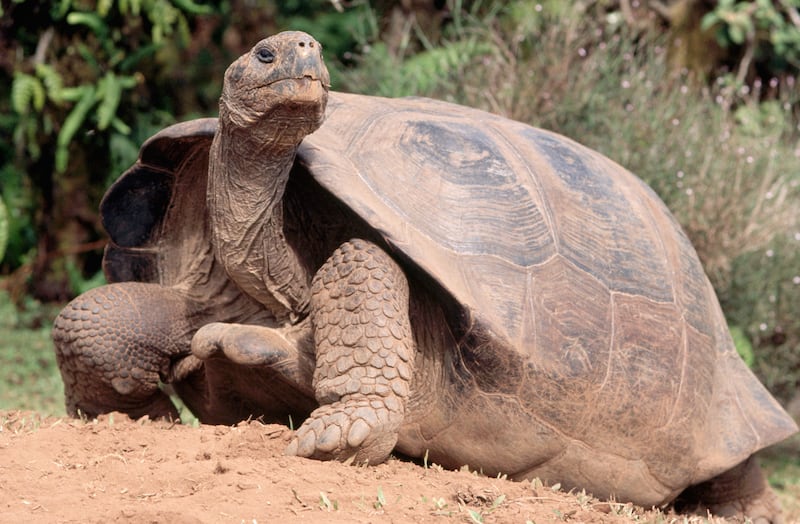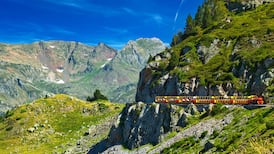I know I am in the Galápagos Islands because when walking from the plane to the terminal building on Baltra Island there’s an iguana asleep in a flower bed right by the edge of the footpath. At first I assume it’s a piece of concrete, a sort of Galápagoan version of a garden gnome, put there as a “Welcome, tourist!” gesture.
But no, he’s real.
Next, the bus that takes everyone from the little ferry linking Baltra Island to the much larger Santa Cruz Island has to stop along the way because there’s an iguana crossing the road. And rather slowly, at that. Why did the iguana cross the road? I’ve no idea, because one side looked pretty much the same as the other – a barren mess of half-dead plants, cactus and mangrove, and volcanic lava debris. From Puerto Ayora, the main town on Santa Cruz – in fact the main town in the whole archipelago – I took a ferry to Puerto Villamil on the neighbouring island of Isabela. It was a bumpy ride, lasting several hours, which I thought would never end. But it was worth it.

The Galápagos Islands are ground zero when it comes to evolution. There are 21 islands, 900km out into the Pacific Ocean, and they straddle the equator. A few are little more than rock outcrops, but a dozen or so are sizeable, and three – Isabela, Santa Cruz and San Cristóbal – contain almost all of the 33,000 people who live in what is a province of Ecuador. When Charles Darwin came here in 1835 during the second voyage of the Beagle, the place had been largely isolated for millions of years. The Spanish arrived in 1535 and various buccaneering British sailors followed suit and mapped the place in 1684. But, for all that, the Galápagos had largely been ignored ... but not by nature.
Darwin was 22 years old when he began his work, spending most of five years observing nature in and around the Pacific, and just five weeks in the Galápagos. But it was sufficient time for him to join a whole pile of dots suggesting that plants and animals adapted to their environment to survive and prosper. Twenty-three years after that voyage of the Beagle, he published On the Origin of Species by Means of Natural Selection, and nothing has been quite the same since.
Sea lions loll about on seaside footpaths, on boats and on jetties. Some even sleep on benches put there for humans
The first thing that strikes a visitor to the Galápagos Islands (well, certainly this one) is that there are animals everywhere. And, the amazing thing is, they don’t seem afraid of people. In fact, they don’t seem the least bit interested in us at all. Sea lions loll about on seaside footpaths, on boats and on jetties. Some even sleep on benches put there for humans but happily turned into beds by the sea lions, who contentedly defecate where they flop. There are even notices saying, “I’m sleeping, please do not disturb”.
The animals have taken over.
On my first morning on Isabela, I take a snorkelling tour to the tunnels, a place about an hour west along the southern coast of the island. First stop is Roca Union, a single rock outcrop maybe a kilometre or three offshore, on which sit several boobies. There are two types of the bird there when we visit, the red-footed booby and the blue-footed booby; the first on top of the rock and the blue-footed cousin on a ledge below, facing inward and not at all interested in us.
The booby is a strange-looking bird. It has a head and face quite like a gannet and a body about the size of a small goose. But its legs are very stumpy and it waddles rather than walks, lifting each foot in turn in a rather exaggerated gesture outwards and upwards and then forwards, as though they have glue on their soles. It was this manner of funny walking that earned it its name – booby means silly in Spanish, says our guide Diego Rivadeneiva.

Deigo takes us to the tunnels at Cabo Rosa, which are made of lava and through which the liquid volcanic rock flowed into the sea. What’s left today is a complex mass of black rocks and broken open tunnel tubes and arches – perfect cover for sea creatures. On top of the tunnels there are nesting sites used by boobies and we get very close to some who, again like other creatures, seem almost completely unfazed by our presence.
Snorkelling around the lava tunnels, a whole different world opens up. There are fish everywhere – parrot fish, puffer fish and yellow-tail damsel fish – all of them sporting electric blue, yellow and pink colours, and there are Pacific sea horses.
Under one of the arches created by the lava, whitetip reef sharks are sleeping. They lie in the water, floating just off the bottom, completely still and seemingly unaware of our presence, or at least uninterested in our being there. They are not huge, perhaps a meter-and-a-half in length and don’t look dangerous at all. According to Diego, who leads us to them, they sleep during the day, but at night they will go further out to sea to hunt shellfish and octopus.
The big thrill comes when we encounter sea turtles. Snorkelling about on the surface – all the time looking down – suddenly one looms out of the half-light ahead; a big thing, maybe 3ft long and a foot-and-a-half wide. He – and it is a he – snuffles along the bottom, ripping out greenery and sending clouds of sand into the water. Lots of electric-coloured fish hang around his mouth, feeding off whatever is in the debris from his pulling up and chomping. We see three or four of them, all sort of lumbering through the water, their flippers active but not flailing in any way, just looking relaxed and going about their feeding.
Again, they seem utterly uninterested in us and not the least bit disturbed by us. I ask Diego about this – why aren’t creatures fearful of humans? Because, he says, they are not hunted and it’s illegal to touch them, let alone try to remove any. And so they just get on with whatever it is they are doing and they are left alone.
Up close, iguanas look ferocious and medieval, or like something out of one of those sci-fi-meets-vikings nonsense series
The same appears to be true for the iguanas. They are everywhere close to water – on the beach, on rock outcrops along the beach, on boardwalks – with big ones up to 3ft long and scores of tiny ones. It appears that they breed rather successfully. You can be sitting on a barstool, look down and suddenly notice that the long black shape in the sand by your feet is not a sleeping cat, but an iguana. Wherever mangroves-meet-sand-meet-jetties, there you will find these totally weird, gargoyle-like little fellows. Up close, they look ferocious and medieval, or like something out of one of those sci-fi-meets-vikings nonsense series. You can see where at least some of the inspiration for Gremlins came.
The next day I went to see the famed Galápagos giant tortoise, which gave the islands their name, again from the Spanish. Darwin noticed small differences between the tortoises on different islands. According to Deigo, on Isabela there are five types of tortoise, each differing slightly from the others in small but not unimportant ways, due to each having grown up on the flanks of different volcanoes. The lava flows off each of Isabela’s five main volcanoes cut the tortoises off from each other (they all came originally, millions of years ago, from Peru and Chile) and so they developed and evolved slightly differently.

At the tortoise sanctuary on Isabela, there are 900 of the creatures, 800 of them newborn (which means, in tortoise span, anything from two years to about seven). The one I looked at most, named No 2 (with stunning lack of imagination), is believed by the sanctuary to be 100-120 years old. Despite that, he’s nimble enough on those feet you would think would have evolved better for walking. The tortoises were removed from the south-facing flank of the Sierra Negra volcano in the late 1990s because predators (rants, birds of prey, dogs, cattle) were killing the young or eating eggs.
Adult tortoises mate for up to five hours, which sounds like we missed out on that bit of evolution. It’s an odd thing but when the female lays eggs and buries them in a 30-40cm deep pit, and defecates and pees on top to put predators off, the young hatch after 160 days and have to get on with life alone. They never know their parents, who have no interest in them at all after the eggs are laid.
Walking back to my hostel, I find half a dozen flamingos feeding in a lake. They are the pinkest pink I have ever seen. They look terribly beautiful and fragile. However, they too seem to thrive here, despite the annual 270,000 or so tourists (retirees and backpackers mainly) who come to look at them, and also wonder at all of the extraordinary creatures in this most unusual place, before flying off to the next stop on that bucket list.
Peter Murtagh is travelling by motorbike from Tierra del Fuego, at the tip of South America, to Alaska, at the top of North America, and writing here regularly. You can also read his blog and follow him on Twitter, Facebook and Instagram










